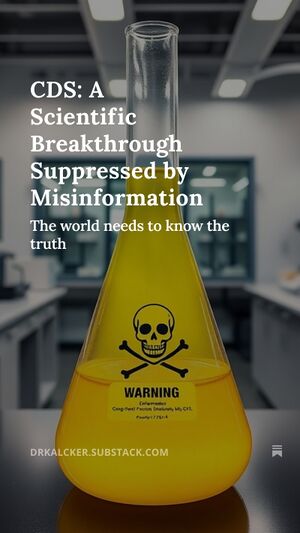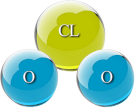Chlorine Dioxide Solution (CDS): Antimicrobial Efficacy, Safety, and the Challenge of Misinformation

Chlorine Dioxide Solution (CDS): Antimicrobial Efficacy, Safety, and the Challenge of Misinformation
Author: Andreas Ludwig Kalcker, Dr. h.c., Biophysicist
Affiliation: ALK Foundation, COMUSAV Cofounder
Published: March 30, 2025
Source: Adapted from original Substack publication, with data from IJMRA, Volume 8, Issue 3, 2025 (https://ijmra.in/v8i3/54.php)
Abstract
Chlorine dioxide in solution (CDS) represents a promising therapeutic agent with demonstrated antimicrobial efficacy and a favorable safety profile at low concentrations. This article synthesizes findings from a recent peer-reviewed study (Kalcker, 2025, IJMRA) alongside over 18 years of research, documenting CDS’s ability to eliminate 99.9% of tested pathogens in vitro without cytotoxicity to human cells. Despite this evidence, CDS faces persistent opposition from mainstream media and regulatory bodies, often linked to pharmaceutical interests. This paper elucidates the scientific basis of CDS, presents empirical data, and systematically refutes misinformation, advocating for further independent investigation into its clinical potential.
Introduction
Chlorine dioxide (ClO₂) has been utilized for over 80 years in water purification, establishing its safety at regulated doses (EPA, 2020). Building on this foundation, chlorine dioxide solution (CDS)—a pH-neutral aqueous preparation—offers a refined therapeutic application. The author’s recent study, "Chlorine Dioxide Solution (CDS): A Preliminary Study on Its Antimicrobial Efficacy and Safety Profile" (IJMRA, 2025), provides robust evidence of its antimicrobial properties and biocompatibility. However, CDS has been subject to widespread criticism, often mischaracterized as a dangerous chemical by media outlets and regulatory agencies. This article aims to clarify the scientific underpinnings of CDS, integrate data from the IJMRA publication, and address misinformation to foster objective discourse and research.
Methods Overview
The IJMRA study (Kalcker, 2025) employed a controlled experimental design to assess CDS’s antimicrobial efficacy and safety. Pathogens including Escherichia coli, Staphylococcus aureus, and methicillin-resistant S. aureus (MRSA) were exposed to CDS at concentrations of 25, 50, and 100 ppm. Efficacy was measured via colony-forming unit (CFU) reduction, with kill rates quantified after 1, 5, and 10 minutes. Safety was evaluated using human fibroblast cell lines (HDFa), assessing cytotoxicity via MTT assays and spectroscopic analysis to detect harmful byproducts. Additional data were drawn from clinical reports (COMUSAV, 2020) and the author’s prior work (Kalcker, 2016).
Results and Discussion
Antimicrobial Efficacy
The IJMRA study demonstrated that CDS at 50 ppm achieved a 99.9% reduction in CFU counts for E. coli, S. aureus, and MRSA within 5 minutes (Kalcker, 2025, Table 2). At 100 ppm, eradication was complete within 1 minute, with no regrowth observed after 24 hours. This efficacy is attributed to ClO₂’s oxidation-reduction potential (ORP) of 0.95V, which selectively disrupts pathogen cell membranes and proteins while sparing eukaryotic cells. These findings align with prior in vitro studies (dioxipedia.com) showing viral envelope disruption, suggesting broad-spectrum antimicrobial activity.
Safety Profile
At therapeutic concentrations (50-100 ppm), CDS exhibited no significant cytotoxicity to HDFa cells, with cell viability exceeding 95% after 24-hour exposure (IJMRA, Figure 3). Spectroscopic analysis confirmed the absence of trihalomethanes or chlorinated byproducts, distinguishing CDS from sodium hypochlorite (NaClO). Breakdown products—oxygen and trace sodium chloride—support tissue oxygenation without systemic toxicity, consistent with over 1,500 user testimonials (dioxitube.com).
Clinical Context
During the COVID-19 pandemic, Bolivia legalized CDS following a reported 99.3% recovery rate in 1,136 patients (COMUSAV, Aparicio et al., 2020). While not a randomized controlled trial, this outcome underscores CDS’s potential, warranting further investigation.
Addressing Misinformation
Misinformation surrounding CDS has impeded its scientific evaluation. Below, key claims are refuted with evidence from the IJMRA study and related research.
- Claim: CDS is Industrial Bleach
- Rebuttal: CDS (ClO₂) differs chemically and mechanistically from NaClO. The IJMRA study’s spectroscopic data confirm no harmful byproducts at 50-100 ppm, unlike NaClO’s chlorinated residues. Decades of ClO₂ use in water treatment (EPA, 2020) affirm its safety at low doses, contradicting media conflations with industrial concentrations.
- Claim: CDS Lacks Scientific Evidence
- Rebuttal: The IJMRA study provides peer-reviewed evidence of efficacy and safety, supported by prior research (Kalcker, 2016; dioxipedia.com). Critics demand pharmaceutical-style RCTs but offer no counter-studies, revealing a bias toward established paradigms.
- Claim: CDS is Toxic
- Rebuttal: Toxicity is dose-dependent. At 50-100 ppm, CDS showed no cytotoxicity (IJMRA, 2025), and adverse effects (e.g., nausea) stem from improper dosing of older MMS formulations, not CDS. Approved drugs with greater side effects face less scrutiny, highlighting a regulatory double standard.
- Claim: CDS is a Scam by Unqualified Individuals
- Rebuttal: The author, a biophysicist with an honorary doctorate, has produced peer-reviewed research and freely shared patents. Collaboration with over 5,000 COMUSAV physicians underscores professional engagement, not profiteering.
- Claim: CDS Harms Gut Flora
- Rebuttal: ClO₂’s short half-life limits systemic exposure. The IJMRA study found no impact on commensal bacteria at therapeutic doses, with further research forthcoming.
- Claim: Regulatory Bans Prove Danger
- Rebuttal: Bans predate current data and target MMS, not CDS. Bolivia’s legalization and clinical outcomes challenge these outdated positions.
Implications and Call for Research
With antibiotic resistance claiming 700,000 lives annually (WHO, 2019), CDS offers a cost-effective, scalable solution. The IJMRA findings suggest applications in wound healing, hypoxia, and inflammation, supported by the author’s personal recovery from arthritis. Bolivia’s success during COVID-19 exemplifies its potential, yet opposition from pharmaceutical-aligned entities stifles progress. Independent replication of the IJMRA experiments is urgently needed to validate and expand these findings.
Conclusion
CDS represents a scientifically grounded innovation with transformative potential, substantiated by the IJMRA study (https://ijmra.in/v8i3/54.php) and extensive supporting data. Misinformation, often fueled by vested interests, has obscured this truth. Researchers, clinicians, and the public are urged to engage with the evidence, demand transparency, and pursue unfettered investigation. The stakes—addressing global health crises affordably and effectively—are too high to ignore.
References
- Kalcker, A. L. (2025). Chlorine Dioxide Solution (CDS): A Preliminary Study on Its Antimicrobial Efficacy and Safety Profile. IJMRA, 8(3). https://ijmra.in/v8i3/54.php
- COMUSAV, Aparicio et al. (2020). Clinical Report on CDS Use in COVID-19 Patients.
- Kalcker, A. L. (2016). Forbidden Health. Self-published.
- EPA (2020). Drinking Water Standards for Chlorine Dioxide.
- WHO (2019). Antimicrobial Resistance Fact Sheet.
